A way to pull a tick from a cat at home: extraction methods
Ticks in cats are a fairly common occurrence, especially if the pet is on a self-walk. And often the owner, having discovered a sucked arthropod, does not know how to get a tick from a cat. He tries to extract the parasite on his own and, through inexperience, can harm the animal even more. And the veterinarian is subsequently forced to eliminate the mistakes of the owner, which can turn into a serious problem for the pet.
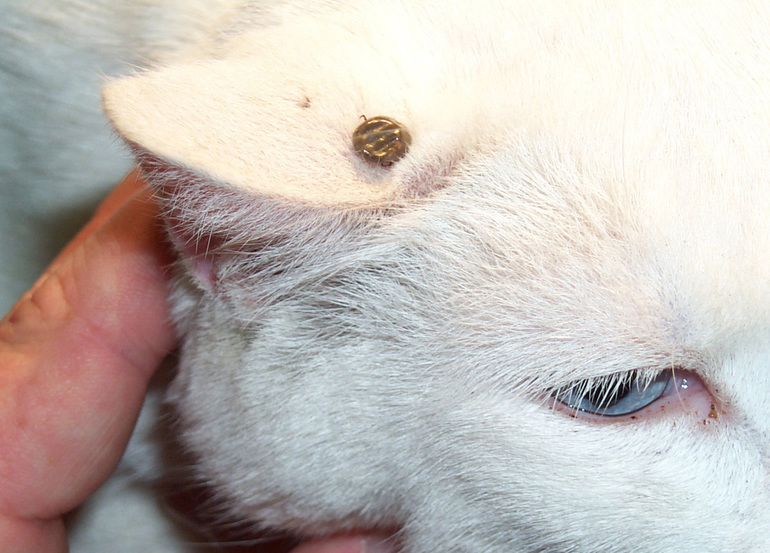
Tick Danger
In nature, there are several types of ticks: ear, ixodic, scabies. Infection with any of them is dangerous for the cat. But the most deplorable consequences await the pet during an attack by an ixodid tick.
Many owners, especially those living in the city, do not even know how the ixodid tick looks externally and, moreover, do not know how to remove it. Distinctive signs of the parasite:
- The body is teardrop-shaped, black or grayish-brown.
- Limbs. Young individuals have 3 pairs of legs, adults - 4.
- The head is small with a proboscis, located on the pointed part of the trunk.
Young or old, it can be a carrier of diseases such as

- Encephalitis is an infection that affects the brain and leads to paralysis and death of the animal. Even after symptomatic treatment, the cat's body will not fully recover.
- Pyroplasmosis is a disease caused by the simplest parasites that live in blood cells. It develops lightning fast. The period from the onset of the first symptoms to the death of the pet is only 2 days.
- Hemobartonellosis is an infectious disease caused by the simplest organisms that parasitize in red blood cells - red blood cells. It does not pose a mortal danger, but causes anemia, a decrease in immunity and an exacerbation of chronic diseases, especially in elderly animals.
It is worth noting that for a person a tick bite is as dangerous as for a cat.
A way to detect a parasite
A tick can be found on a pet’s body (especially a long-haired one) only when it is already full of blood. Therefore, animals that walk outside on their own should be inspected daily and when a tick is found in a cat, remove it as quickly as possible. To do this, provide good lighting and comb with frequent teeth. Inspection Recommendations:
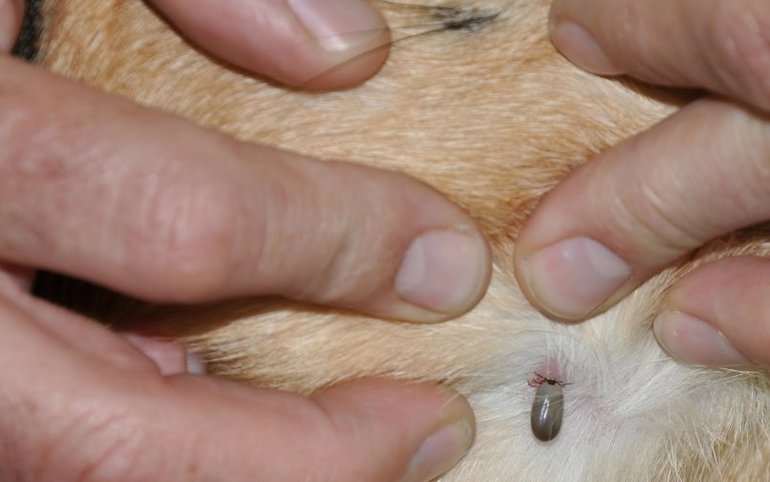
- To avoid aggression, the examination begins when the pet is full or is preparing for bed.
- The cat is placed on any flat horizontal surface covered with light cloth (you can immediately notice an arthropod on it if it has fallen out of hands).
- First of all, they examine the ears, neck, stomach, armpit area and the inner surface of the hips (in these places thin and delicate skin, and the tick easily bites through it).
- Carefully comb the hair against hair growth and feel the skin.
- Noticing the sucking parasite, you should continue the search, perhaps it is not the only instance. It will be easier to remove ticks all at once, knowing the places of their defeat.
The examination is recommended to be carried out with gloves, as checking the cat's hair with unprotected hands can result in the tick attacking the person.
The reason for an immediate inspection is the changed behavior of the pet. Kitty becomes nervous, constantly licking hair. This is a sign that the tick has long been on the skin of the pet.
Before removing the parasite, hands and tools should be treated. Pet skin does not need to be processed.To get a tick correctly from a cat, you need to perform simple steps: securely fix the animal on the table and ask someone from home for help in carrying out the procedure. Many animals do not tolerate familiarity and will defend themselves.
Extraction methods
There are several ways to get rid of a sucked parasite. It is best to pull out the arthropod using a pliers (plastic hook with a slot at the end) or a lasso handle with an eyelet. You can also use ordinary tweezers. The algorithm of actions is as follows:
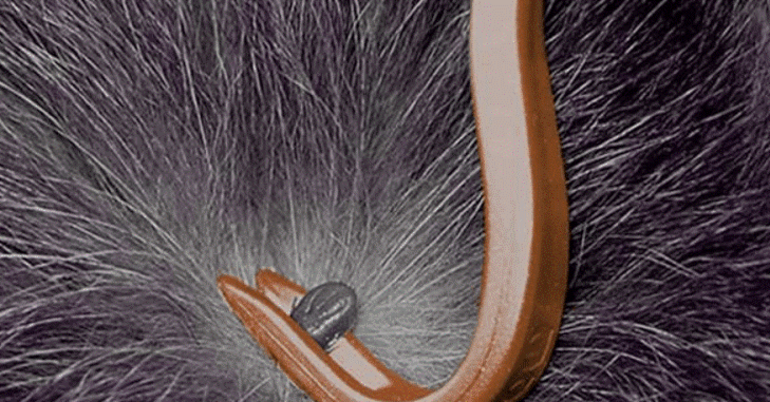
- Locate the tick.
- Spread the coat and remove the parasite.
- Get rid of the tick (this must be done).
- The area around the wound is treated with a solution of peroxide or alcohol, then greased with iodine.
If kitty is allergic, you should give it an antihistamine, for example, suprastin, and smear the wound with anti-allergenic ointment instead of iodine.
In order to remove a tick from a cat with tick-borne, a lasso pen or other tools, it is necessary to study the nuances of their application in advance. Retrieval Methods:
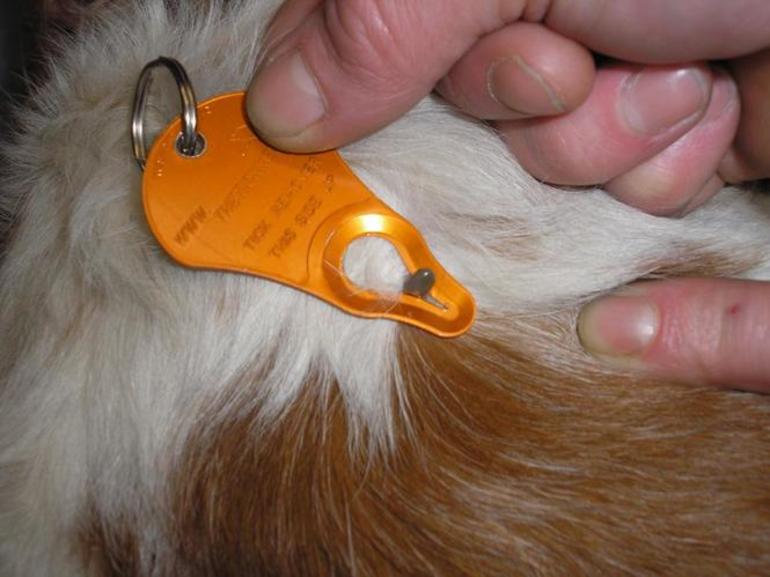
- Mite tick. Carefully thread the tip of the hook into the slot right between the skin of the animal and the sucking parasite (so that the tick is firmly fixed). Then turn the tool against its axis and unscrew the tick.
- A lasso handle with a soft loop that is worn on the arthropod body and securely fixed at the point of suction of the tick. The device is rotated in any direction until the parasite is completely removed.
- Tool with a rigid eyelet. The body of the bloodsucker is introduced into the wide part of the loop, then it is shifted so that the place of contact of the tick is in the narrow part, and he himself is securely fixed. With a careful turn, they try to bring out a live tick so that the head does not get stuck under the skin of the cat.
- Forceps or clamp. By holding it vertically or parallel with a tool so that the tips come in contact with the skin of the animal, they capture the arachnid and smoothly remove.
- Thread. A thread loop is applied to the parasite and pulled.
When no devices are available, the parasite will have to be pulled out by hand. To do this, use gloved hands to capture the arachnid and, trying not to press hard on the body of the bloodsucker, turn it around its axis, pull it out and temporarily put it away.
Then you should examine the site of the bite. This is done in order to make sure that the head of the tick does not remain under the skin. If after removing the parasite, a black spot or a red bump remains at the site of the bite, then the head remains under the skin. It needs to be removed. To do this, the cone is treated with alcohol and carefully pulled out with a sewing needle, but it is better if the procedure is carried out by a veterinarian.
Things you should not do
Do not believe the advice of "knowledgeable people" that a sucked parasite can be easily removed with vegetable oil or alcohol. This absolutely useless procedure will only aggravate the situation, because a disturbed bloodsucker will begin to inject poisonous enzymes under the cat’s skin, this can contribute to infection of the animal if the tick is a carrier of any disease. And also when removing the tick, do not do the following:
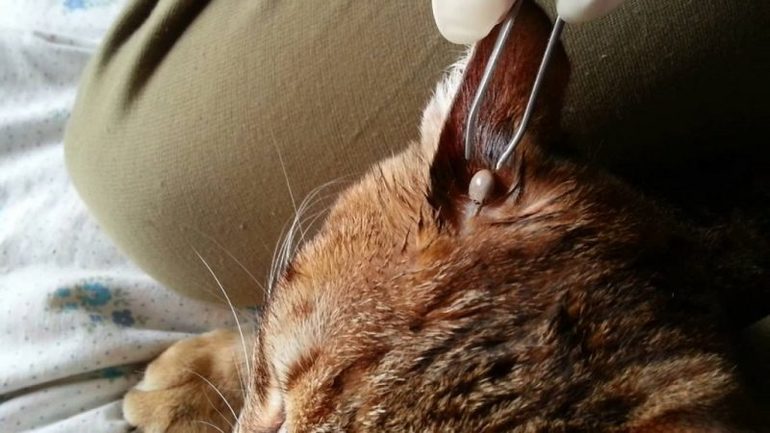
- try to crush the arachnid on the cat's skin;
- pick out with a needle;
- pull out sharply with your hand;
- try to burn a cigarette;
- make lotions from gasoline or ammonia.
It is better to go to the veterinary clinic, where the specialist will carry out all the necessary procedures.
Infection prevention
If the cat or cat is self-walking, protect the pet from getting bloodsuckers on the skin as much as possible. After returning from a walk, a pet can bring a parasite into the house, while people, especially children, can suffer.
The owner is advised to choose the tool that is most suitable for the cat. Moreover, in veterinary pharmacies there is a large selection of various accessories and preparations. It can be:

- Anti-mite collar soaked in a special preparation and protecting the cat from 3 to 5 months.Its application is simple. You just need to put it on the animal’s neck and securely secure it, trying to keep a distance of 1.5−2 cm between the collar and the neck.
- Spray is the most effective tool for combating bloodsuckers. The drug is applied to the body of the animal, strictly under the fur along the back, so that the cat could not lick the poison. And also you need to try not to get into the eyes of the pet. The procedure is performed in the open air or on the balcony. In extreme cases, you need to open the windows in the house.
- Drops on the withers are applied between the shoulder blades, spreading the wool. The advantage of the drug is that it can be used for kittens and pregnant cats, but not more than 1 time per month.
Be sure to familiarize yourself with the instructions attached to the drug or collar before using any antiparasitic drug. If intoxication has gone, the pet should be shown to the veterinarian.
Even kittens of purely domestic content are not immune from the attack of ticks, and owners should understand the potential danger that a walker can bring into the house. To protect the pet from parasite attacks is the task of the owner, who is fully responsible for his ward.
- How to choose a vacuum cleaner taking into account the characteristics of the house and coatings?
- What to look for when choosing a water delivery
- How to quickly create comfort at home - tips for housewives
- How to choose the perfect TV - useful tips
- What to look for when choosing blinds
- What should be running shoes?
- What useful things can you buy in a hardware store
- Iphone 11 pro max review
- Than iPhone is better than Android smartphones



